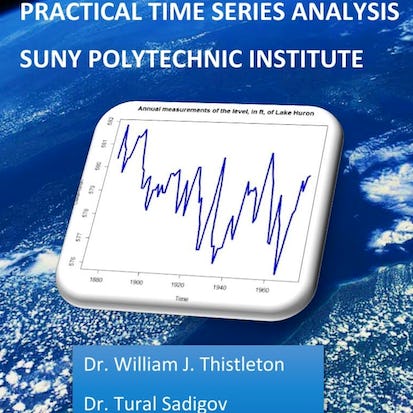- Level Professional
- المدة 26 ساعات hours
- الطبع بواسطة The State University of New York
-
Offered by

عن
Welcome to Practical Time Series Analysis! Many of us are "accidental" data analysts. We trained in the sciences, business, or engineering and then found ourselves confronted with data for which we have no formal analytic training. This course is designed for people with some technical competencies who would like more than a "cookbook" approach, but who still need to concentrate on the routine sorts of presentation and analysis that deepen the understanding of our professional topics. In practical Time Series Analysis we look at data sets that represent sequential information, such as stock prices, annual rainfall, sunspot activity, the price of agricultural products, and more. We look at several mathematical models that might be used to describe the processes which generate these types of data. We also look at graphical representations that provide insights into our data. Finally, we also learn how to make forecasts that say intelligent things about what we might expect in the future. Please take a few minutes to explore the course site. You will find video lectures with supporting written materials as well as quizzes to help emphasize important points. The language for the course is R, a free implementation of the S language. It is a professional environment and fairly easy to learn. You can discuss material from the course with your fellow learners. Please take a moment to introduce yourself! Time Series Analysis can take effort to learn- we have tried to present those ideas that are "mission critical" in a way where you understand enough of the math to fell satisfied while also being immediately productive. We hope you enjoy the class!الوحدات
Welcome to Practical Time Series Analysis
1
Videos
- Course Introduction
R software setup
4
Videos
- Week 1 Welcome Video
- Getting Started in R: Download and Install R on Windows
- Getting Started in R: Download and Install R on Mac
- Getting Started in R: Using Packages
2
Readings
- Welcome to Week 1
- Getting Started with R
Review of basic descriptive and inferential statistics
2
Assignment
- Visualization
- Basic Statistics Review
3
Labs
- Codes for Concatenation, Five-number summary, Standard Deviation
- Codes for Histogram
- Codes for Scatterplot
7
Videos
- Concatenation, Five-number summary, Standard Deviation
- Histogram in R
- Scatterplot in R
- Review of Basic Statistics I - Simple Linear Regression
- Reviewing Basic Statistics II More Linear Regression
- Reviewing Basic Statistics III - Inference
- Reviewing Basic Statistics IV
2
Readings
- Basic Statistics Review (with linear regression and hypothesis testing)
- Measuring Linear Association with the Correlation Function
Welcome to Week 2
1
Videos
- Week 2 Welcome Video
Visualizing and Describing a Time Series: time plots, autocovariance, and autocorrelation
1
Assignment
- Noise Versus Signal
6
Videos
- Introduction
- Time plots
- First Intuitions on (Weak) Stationarity
- Autocovariance function
- Autocovariance coefficients
- Autocorrelation Function (ACF)
1
Readings
- All slides together for the next two lessons
How do we model Time Series? Random Walks and an Introduction to Moving Averages
2
Assignment
- Random Walk vs Purely Random Process
- Time plots, Stationarity, ACV, ACF, Random Walk and MA processes
1
Labs
- Simulating MA(2) process - codes for the next video lecture
3
Videos
- Random Walk
- Introduction to Moving Average Processes
- Simulating MA(2) process
Welcome to Week 3
1
Videos
- Week 3 Welcome Video
Stationarity: generalizing from an individual to a group
1
Assignment
- Stationarity
3
Videos
- Stationarity - Intuition and Definition
- Stationarity - First Examples...White Noise and Random Walks
- Stationarity - First Examples...ACF of Moving Average
3
Readings
- Stationarity - Examples -White Noise, Random Walks, and Moving Averages
- Stationarity - Intuition and Definition
- Stationarity - ACF of a Moving Average
The Backshift Operator applied to MA(q) and AR(p) processes.
1
Assignment
- Series, Backward Shift Operator, Invertibility and Duality
5
Videos
- Series and Series Representation
- Backward shift operator
- Introduction to Invertibility
- Duality
- Mean Square Convergence (Optional)
1
Readings
- All slides together for lesson 2 and 4
AR(p) processes
1
Assignment
- AR(p) and the ACF
2
Videos
- Autoregressive Processes - Definition, Simulation, and First Examples
- Autoregressive Processes - Backshift Operator and the ACF
2
Readings
- Autoregressive Processes- Definition and First Examples
- Autoregressive Processes - Backshift Operator and the ACF
Intro to Yule- Walker equations.
1
Assignment
- Difference equations and Yule-Walker equations
2
Videos
- Difference equations
- Yule - Walker equations
1
Readings
- Yule - Walker equations - Slides
Welcome to Week 4
1
Videos
- Week 4 Welcome Video
Employ PACF to estimate the order of AR( p ) processes.
1
Assignment
- Partial Autocorrelation
2
Videos
- Partial Autocorrelation and the PACF First Examples
- Partial Autocorrelation and the PACF - Concept Development
2
Readings
- Partial Autocorrelation and the PACF First Examples
- Partial Autocorrelation and the PACF: Concept Development
Write Yule-Walker equations in matrix notation, and estimate model parameters in AR(p) processes.
1
Assignment
- Yule-Walker in matrix form and Yule-Walker estimation
2
Labs
- AR(2) Simulation (Parameter Estimation)
- AR(3) Simulation (Parameter Estimation)
3
Videos
- Yule-Walker Equations in Matrix Form
- Yule Walker Estimation - AR(2) Simulation
- Yule Walker Estimation - AR(3) Simulation
1
Readings
- All slides together for the next two lessons
AR processes - Data Oriented Examples
1
Assignment
- 'LakeHuron' dataset
2
Labs
- Recruitment - model fitting
- Johnson & Johnson-model fitting
2
Videos
- Recruitment data - model fitting
- Johnson & Johnson-model fitting
Welcome to Week 5
1
Videos
- Week 5 Welcome Video
Judge the quality of the fitted model by using Akaike Information Criterion (AIC).
1
Assignment
- AIC and model building
1
Videos
- Akaike Information Criterion and Model Quality
1
Readings
- Akaike Information Criterion and Model Quality
ARMA
1
Assignment
- ARMA Processes
2
Videos
- ARMA Models (And a Little Theory)
- ARMA Properties and Examples
2
Readings
- ARMA Models and a Little Theory
- ARMA Properties and Examples
ARIMA
2
Assignment
- ARIMA and Q-statistic
- 'BJsales' dataset
2
Labs
- ARIMA(2,1,1) Simulation
- Daily birth - R code
3
Videos
- ARIMA Processes
- Q-Statistic
- Daily births in California in 1959
3
Readings
- All slides together for this lesson
- Daily birth dataset
- Daily female birth (R file)
Welcome to Week 6
1
Videos
- Week 6 Welcome Video
SARIMA
1
Assignment
- SARIMA processes
2
Videos
- SARIMA processes
- ACF of SARIMA models
2
Readings
- All slides together for the next two lessons
- SARIMA simulation (code block)
Applications
1
Assignment
- 'USAccDeaths' dataset
2
Labs
- SARIMA code for Milk production
- SARIMA code for Sales at a souvenir shop
3
Videos
- SARIMA fitting: Johnson & Johnson
- SARIMA fitting: Milk production
- SARIMA fitting: Sales at a souvenir shop
1
Readings
- SARIMA code for J&J (code block)
Forecasting with Smoothing Techniques
1
Assignment
- Forecasting
4
Videos
- Forecasting Using Simple Exponential Smoothing
- Double Exponential Smoothing
- Triple Exponential Smoothing Concept Development
- Triple Exponential Smoothing Implementation
3
Readings
- Forecasting using Simple Exponential Smoothing
- Forecasting Using Holt Winters for Trend (Double Exponential)
- Forecasting Using Holt Winters for Trend and Seasonality (Triple Exponential)
Auto Summary
Practical Time Series Analysis is a comprehensive course on sequential data analysis, ideal for professionals in sciences, business, or engineering seeking to deepen their analytic skills. Led by Coursera, it covers mathematical models, graphical data representation, and forecasting, using R programming. The course offers engaging video lectures, written materials, and quizzes, over a duration of approximately 26 hours. Subscription options include Starter and Professional levels. Perfect for those looking to enhance their data analysis capabilities beyond basic techniques.

Tural Sadigov

William Thistleton


